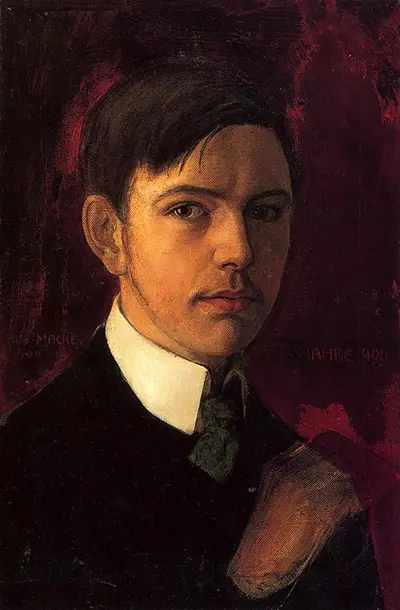August Macke is rightly considered one of the true masters of colour and despite his short career this famous German artist left behind an impressive oeuvre of work, including oil and watercolour paintings and drawings.
Macke drew in a whole plethora of influences in the early stages of his career, with his final chosen style being described by most as a combination of Post-Impressionism, Expressionism and Fauvism. The latter was due purely to the bright colours that flooded most of his work. He did not dwell too much on detail, rather focusing on areas of colour which together produced the finished composition. This approach was actually better suited to watercolours than oils, but he impressed in both art forms.
Many artists of this period, and in the centuries before, went on journeys of discovery around Europe and sometimes North Africa. They would find unique balances of light and colour which would inspire their work, as well as being able to study other famous artists close up. August Macke completed this same period of curiosity and because of his short lifespan, artworks from these trips make up a larger proportion of his work than they might for most other artists. Switzerland and Tunisia were to be two of his most significant destinations, offering contrasting conditions for his development.
Along the way Macke would also count several of the most famous artists in all art history amongst his friends and colleagues. This was a time of great artistic strength in Germany at that time, with several key names pushing the boundaries of what could be considered art. Swiss painter Paul Klee was one such individual and also shared a love for colour, just like August. Furthermore, Franz Marc also played a significant role in his life and the two would spend considerable amounts of time in each other's studios. Macke can be considered an important artist due to the quality of his work as well as how he contributed to a golden era in art across this region of mainland Europe (predominantly Germany, Austria and Switzerland).
The content found in Macke's paintings were, most commonly, cityscapes and landscapes. He would go through phases where one would dominate over the other, mainly caused by his location at the time. This artist also liked to capture portraits in a natural setting, often with a group of figures superimposed onto a stunning backdrop. Two of his most famous paintings capture these types of content, namely Woman in a Green Jacket and Milliner: Woman with Parasol in front of Milliner's Shop. All of his major artworks are featured in this website, which has taken great time and care in order to uncover as much about his life and career as possible. More is uncovered in our extensive biography which will help to outline his path to academic acceptance.
The use of minimal detail from Macke would continue further into the extremes of abstraction. A series titled Coloured Forms in 1913 marked his pinnacle in this style, where objects were now entirely indistinguishable. The colour scheme was still bright, brilliant and very August Macke. His movement towards such a level of abstract art was rare, though. Most paintings continued an expressive depiction of recongisable scenes of everyday leisure time across Europe. Zoos, circuses and parks appeared as well as countless shopping experiences.
It was then in 1914 that the artist continued his cityscape work but from an entirely different location - Tunisia. This naturally brought in a new theme of work with different architecture, clothing and even a greater saturation of light. He was joined on this journey by Paul Klee and Louis Moilliet and they spent a highly fruitful two weeks in this intriguing country. Klee shared a similar passion for colour to Macke and had also studied the theories around it in great detail, later producing his own literature detailing his discoveries. In a similar experience to several French artists who found a different type of light in the southern regions of their own country, this group had the same in cities like Tunis.
August Macke was a highly outspoken individual who was also naturally passionate about his work and art in general. Our comprehensive list of August Macke quotes gives an insight into several significant German art movements in their early days. Much of this information was retrieved from letters, the most common form of correspondence during the 19th and much of the 20th centuries. In these letters he revealed his opinions on fellow members of Neue Künstlervereinigung München, Der Blaue Reiter plus the true modern master, Wassily Kandinsky. His view of Kandinsky changed over time as their careers developed and it can be tracked through his letters to Franz Marc and his wife.
Macke's legacy was unquestionably damaged by his tragic early loss but there still remains a general acceptance among academics of the important role that he played in drawing together all manner of different art movements to create a bright, exciting and unique approach to art. His impressive list of connections also have helped to keep his name in the news as have several of the highly celebrated artistic journeys of discovery that he was involved. As German art continues to be celebrated, particularly for the past two centuries, Macke's work will remain prominent and highly prized.




